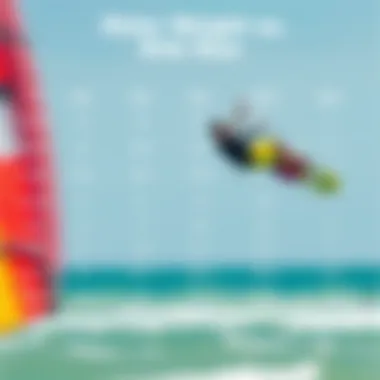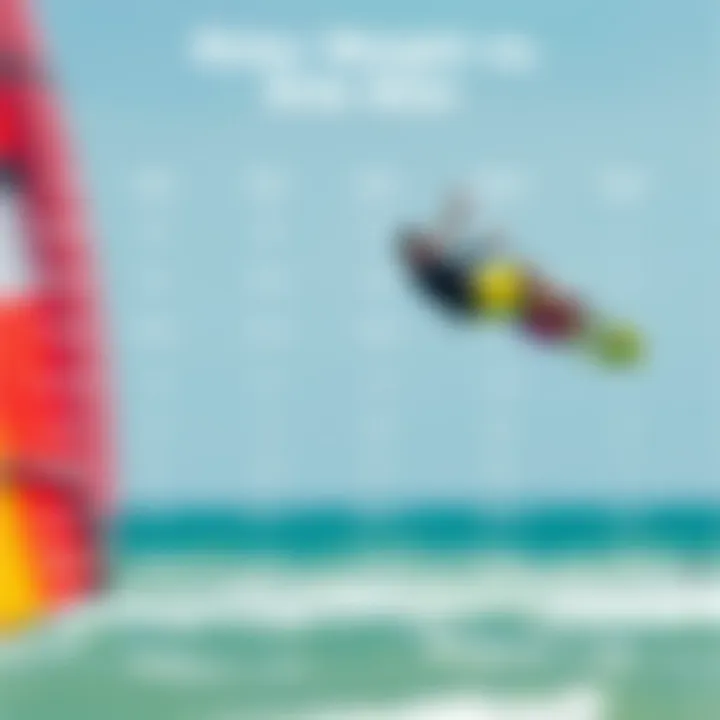Choosing the Right Kite Size for Kiteboarding


Intro
Kiteboarding brings a unique blend of thrill and strategy, and at its core lies the critical decision of kite size. Navigating the vast waters, where wind dynamics play a pivotal role, the kite acts as the bridge between rider and element. Understanding the ins and outs of kite sizes means diving deep into an array of factors - wind strength, personal weight, and skill level, to name just a few. It’s not merely about picking the biggest kite; it’s about making an informed choice that aligns with your riding style and conditions.
As we uncover the intricacies of kite sizes, riders, whether novices looking to catch their first gust or seasoned pros honing advanced techniques, will find solid insights to elevate their experience. This guide serves as your compass in the expansive landscape of kiteboarding. Let’s embark on this journey and unlock the secrets to selecting the perfect kite that sings in harmony with the wind.
The Importance of Kite Size in Kiteboarding
Choosing the right kite size is not merely about following guidelines; it is a fundamental element that can greatly impact your kiteboarding experience. The interplay between kite size, wind conditions, rider weight, and individual style creates a complex matrix that requires careful navigation. Understanding kite size is essential not only for safety but also for maximizing performance and enjoyment on the water.
When selecting a kite, you must recognize that mismatched sizes can yield frustrating or even dangerous experiences. A kite that is too small may lead to insufficient lift in light winds, while an oversized kite can become uncontrollable in stronger winds. It is crucial to grasp not only how size affects your riding but also why it matters, particularly in various conditions.
Knowing this, riders can select kites that will suit their riding style, whether they prefer cruising along flat waters or jumping waves. The right kite size enhances controllability, ensures better stability, and ultimately contributes to a safer and more thrilling ride.
"A well-sized kite is a rider's best friend—too large or too small and you're just making it harder on yourself."
Understanding Kite Size Basics
Kite size is typically measured in square meters, which refers to the surface area of the kite. Most riders tend to gravitate towards the size that aligns with their weight and the prevalent wind conditions. For instance, a heavier rider in moderate wind might do well with a larger kite, while a lighter rider could find a smaller kite more manageable.
One pertinent aspect to keep in mind is that kite designs have evolved significantly. Hence, different shapes can produce varying performance levels despite having the same surface area. For instance, a delta-shaped kite may deliver enhanced lift and stability compared to a traditional C-shaped kite of the same size. Therefore, it is prudent to consider not just the size but also the specific design and functionality of the kite you are choosing.
Impact of Size on Performance
The influence of kite size stretches beyond mere dimensions; it encapsulates the essence of performance on the water. Bigger kites catch more wind, providing greater lift, which can be advantageous for jumping and freestyle maneuvers. Conversely, smaller kites can be easier to control, facilitating better turns and agile movements in rough water.
Many practitioners discover that size selection can determine how responsive and dynamic your ride is. If you find yourself riding consistently in high-wind conditions, a smaller kite could yield quicker reactions and better performance. Conversely, in light wind, a larger kite allows you to harness every puff of air, enabling smoother glides over the surface.
Furthermore, your personal riding style must also figure into the equation. Freestyle riders may favor different sizes than those focused on wave riding. Those who venture into advanced tricks might find that a specific size enhances their legitimacy and success during maneuvers, while recreational riders might prefer a kite that provides ease of use and stability.
In closing, understanding kite size is fundamental to kiteboarding. It aligns with safety and performance—ensuring one can navigate the waters effectively and indulge in the style of riding they cherish most.
Key Factors Influencing Kite Size Selection
Choosing the right kite size is crucial for a fulfilling kiteboarding experience. It's not just a matter of picking the largest or smallest kite off the rack; it's about understanding how several interrelated factors can affect performance and enjoyment on the water. For kiteboarders, whether beginners or seasoned pros, the kite's size can profoundly alter the dynamics of their ride. The interplay between rider weight, wind conditions, and personal skill all shape the decision-making process of selecting a kite size.
One of the biggest benefits of comprehending these key factors is that it significantly enhances control and maneuverability while riding. Furthermore, it allows for a safer and more enjoyable experience in varying conditions.
This section delves into three main components that influence kite size selection: rider weight considerations, wind conditions, and skill level. By breaking down these elements, riders can better grasp the importance of selecting an appropriate kite size, as well as the potential pitfalls of making an ill-informed choice.
Rider Weight Considerations
Rider weight is one of the foremost factors in determining kite size. Generally, a heavier rider may prefer a larger kite, while lighter individuals may find success with a smaller one. This preference arises from the need to generate sufficient lift and power based on body weight.
- Larger Kites for Heavier Riders: For someone weighing over 200 pounds, a kite in the range of 12 to 15 meters could be optimal, particularly in lighter winds.
- Smaller Kites for Lighter Riders: A person around 150 pounds might opt for a kite that’s about 9 to 11 meters, allowing for better handling and responsiveness.
These are rough guidelines; different models and brands may have varying characteristics. So, it’s essential to test kites whenever possible. Sometimes, that magic kite that feels right for you exists in a size that doesn’t strictly align with the guidelines.
Wind Conditions and Their Effects
Wind conditions have a direct impact on how a kite performs and the size that best suits any given situation. Factors such as wind strength and consistency can either enhance or hinder a rider's experience. Here’s how:
- Light Winds: In around 10-12 knots, larger kites are preferable as they catch more wind. A range of 12 to 15 meters can help a rider stay afloat and enjoy their time on the water.
- Moderate Winds: At approximately 15-20 knots, kites between 9 to 12 meters can balance power and control effectively, offering versatility in performance.
- Strong Winds: In turbulent conditions, 7 to 9 meter kites can help maintain agility and reduce the risk of overpowering the rider.
Monitoring wind conditions closely is thus essential; failing to do so may lead to inadequate performance or even dangerous situations.


Skill Level and Experience
Finally, a rider’s skill level plays a significant role in the kite sizing equation. Experienced riders often feel more comfortable handling smaller kites in a range of conditions, allowing for agile movements and quick reactions. In contrast, beginners may benefit from slightly larger kites that provide extra stability and lift, making it easier to learn fundamental skills.
- Beginners: A kite size of around 10-12 meters in moderate conditions can assist new riders in feeling more secure as they learn the ropes.
- Intermediate to Advanced Riders: As one’s skills advance, shifting toward smaller kites can help in performing complex maneuvers or tricks, as they allow for a quicker response and increased control.
The key takeaway here is to be adaptable. While certain sizes may be recommended based on experience, don’t feel tied down; experimentation is invaluable. Adjusting style and approach is often part of the growth in your kiteboarding journey.
In summary, taking into account rider weight, wind conditions, and skill level creates a more comprehensive understanding of kite size selection, ultimately leading to a more enjoyable and dynamic kiteboarding experience.
Kite Size Chart: An Overview
In the realm of kiteboarding, understanding the dynamics of kite size is paramount. The kite size chart serves as a cornerstone for both novice and seasoned riders, acting like a compass, guiding one through the often turbulent waters of size selection. A well-structured kite size chart simplifies the decision-making process, allowing riders to quickly assess the appropriate size based on various factors including rider weight, wind conditions, and skill level.
When selecting a kite size, the chart helps in identifying not only the standard recommendations but also the adjustments necessary for varying environmental conditions. Mistakes in size selection can lead to frustrating experiences on the water, ranging from inadequate lift to excessive power that’s hard to control. Thus, having a solid grasp of kite size specifications can significantly enhance performance and safety.
Standard Kite Size Recommendations
Kites come in a variety of sizes, typically measured in square meters. Understanding standard kite size recommendations offers a baseline for riders to optimize their performance. Here’s a brief list of standard sizes categorized by rider weight:
- Lightweight Riders (up to 65 kg): Recommended kite size between 7 to 9 m² for steady winds.
- Medium Weight Riders (66 kg to 80 kg): Generally, a kite between 9 to 12 m² is suitable.
- Heavyweight Riders (81 kg and above): A size range of 12 to 15 m² often works best, especially in lighter winds.
These standards can help to ensure that riders have enough power to get moving without overloading the kite when the winds pick up. However, it’s crucial to consult local wind and water conditions in addition to these recommendations.
Adjustments for Varied Conditions
The beauty of kiteboarding lies in its adaptability to conditions; hence, adjustments for varied conditions need to be taken into account. Wind strength and quality can fluctuate, compelling riders to alter their kite size accordingly. It is essential to recognize several factors when making these adjustments:
- Wind Strength:
- Riding Style: A rider aiming for different styles might choose smaller kites for tricks and freestyle versus larger kites for wave riding.
- Environmental Factors: Local geographical features—like hills or buildings—can create gusty winds that may necessitate changes in kite size during a session.
- Light Winds (under 12 knots): Consider larger kites to harness as much power as possible.
- Moderate Winds (12-20 knots): A mid-range kite will likely provide the right balance.
- Strong Winds (over 20 knots): Smaller kites help maintain control and reduce the risk of overpowering.
Each rider must approach their size selection thoughtfully, perhaps observing how their peers adjust their gear to cope with similar changing conditions, collecting insights that come in handy on the water. Utilizing the kite size chart doesn’t just elevate performance, it acts as a protective measure against the unpredictable nature of wind, making the entire kiteboarding experience more rewarding.
Types of Kites and Their Size Variations
Understanding the nuanced distinctions between various types of kites is vital for any kiteboarder aiming to enhance their riding experience. The right type of kite can greatly influence performance, control, and overall satisfaction on the water, making the choice far from trivial.
Open Cell vs. Closed Cell Kites
Open cell kites, often seen in the realm of foil kites, are designed with strategically placed openings. These facilitate airflow, resulting in excellent lift and stability when conditions are optimal. Their lightweight nature often translates to quicker responsiveness, which can be a game changer during freestyle sessions. However, open cell kites may not perform as well in turbulent winds due to their susceptibility to collapsing in gusty conditions. So, if you're cruising in steady winds, these can be a great option, but when the wind decides to throw a tantrum, hold tight!
On the flip side, closed cell kites offer a robust and reliable performance. With their sealed design, they excel in a variety of wind conditions, ensuring that the rider enjoys a consistent experience. The ability to retain air means that even in slight lulls, these kites can maintain their lift. This, however, comes at a slight weight cost, making them not quite as nimble as their open cell counterparts. But if durability and versatility are what you seek, closed cell kites might just be your best bet.
In summary, riders must consider their typical wind conditions and riding style. For those in variable winds, closed cell kites provide safety and stability; however, in ideal conditions, open cell kites can offer unparalleled performance.
"Choosing the right type of kite can make all the difference in your performance on the water. Don't rush it, analyze the conditions!"
Foil Kites and Their Size Application
Foil kites, in contrast to traditional inflatable kites, often utilize a series of internal cells to hold their shape. This design allows for an interesting blend of performance attributes. They tend to be lighter than inflatables, which can enhance speed and provide a more engaging ride. They are also compact, making them easier to transport.
When it comes to size application, foil kites can be quite versatile. Riders often find that a larger foil kite allows for a smoother ride, especially in light winds. However, they can be less efficient in strong winds, where smaller sizes might shine due to reduced drag. Therefore, it’s essential to gauge the typical wind conditions you will be dealing with and choose a kite size that aligns with that environment.
Additionally, the rider's skill level plays a major role in kite size selection. Beginners may find larger sizes to be more forgiving and easier to control, while advanced riders may prefer smaller kites for tighter maneuverability and greater control during tricks.


Practical Tips for Choosing the Right Kite Size
When it comes to kiteboarding, selecting the right kite size is a game changer. It can mean the difference between gliding effortlessly across the water or struggling against the elements. Knowing how to choose a kite that fits your weight, height, and riding style elevates not just your performance, but also your overall experience on the water. Here are practical tips that will help you navigate this crucial decision-making process.
Conducting a Personal Assessment
Evaluating Weight and Height
Your weight and height play a crucial role in determining the appropriate kite size. Heavier riders generally need larger kites to generate enough lift in various wind conditions, while lighter riders tend to benefit from smaller kites that are easier to maneuver. Height can also influence how the rider interacts with the kite. Taller individuals may find that their center of gravity shifts, thus needing different kite sizes for optimal performance.
One key takeaway here is to recognize that using a kite that's too small may lead to underperformance, especially in lighter winds. Conversely, a kite that's too large can make it difficult to control, particularly for beginners. Finding the sweet spot is essential. A good practice is to check manufacturer size guides, as they often provide recommendations based on rider weight ranges, giving you an excellent baseline to start with.
Advantages and Disadvantages
- Advantages: Aligning your kite size with your body weight leads to improved lift and stability.
- Disadvantages: If you misjudge your size requirements, you might either be overpowered or underpowered—both scenarios lead to frustration.
Assessing Skill Level
Your skill level is another pivotal factor in kite size selection. Beginners might find larger kites more manageable, as they generally generate more power and easier lift, assisting in achieving an enjoyable ride. However, more experienced kiteboarders often prefer smaller kites for their increased maneuverability and responsiveness to subtle inputs.
It's important to consider that as your skills develop, the kite size that once suited you may no longer feel right. Transitioning to a smaller kite can enhance your performance, offering a more direct connection to the water and better control over your movements. Calibration between your skill level and kite size can ultimately lead to a safer and more engaging ride.
Advantages and Disadvantages
- Advantages: Choosing the right kite according to your skill level can enhance your learning process and increase safety.
- Disadvantages: Newer riders may feel overwhelmed with a kite that's too advanced, leading to potential accidents or burnout from trying to keep up with more skilled peers.
Testing Different Sizes
Trial Sessions
Once you have made initial assessments of your weight, height, and skill level, the next step is to engage in trial sessions with various kite sizes. It can be invaluable to experience firsthand how different kites react in different wind conditions. This practical experience will help you determine which kite aligns best with your style and comfort level.
Trial sessions also help in building confidence. After you have spent time testing various sizes, you'll likely develop a clearer sense of how each kite behaves, allowing you to adjust your preferences accordingly. Remember, what feels good on land might not always align with the reality of being on the water.
Advantages and Disadvantages
- Advantages: Real-world experience provides deeper insights that no chart can offer; it's a way to directly evaluate performance.
- Disadvantages: It may require access to several kites, which can be challenging and costly for readers who are starting out.
Feedback from Instructors
Insights from seasoned instructors can be incredibly beneficial when making decisions about kite size. They often have a wealth of experience and can provide personalized recommendations based on your unique skill set and aspirations as a rider. Their objective views can help you avoid common pitfalls, not to mention give you tips specific to your riding style and the locations where you plan to ride.
Instructors can also help you refine your technique, which in turn can further influence your kite size choice. The nuance they bring to kiteboard instruction can mean the difference between struggling and soaring as you grow your skills.
Advantages and Disadvantages
- Advantages: Instructors can offer personalized advice that can expedite your learning curve.
- Disadvantages: Finding an experienced or compatible instructor might take some time, and not all feedback will resonate with every rider.
Kiteboarding is not just about picking up a board and a kite; it's about understanding how all elements tie together for an unforgettable experience on the water.
With these practical tips on choosing the right kite size in hand, you're now equipped to make informed decisions that can transform your kiteboarding adventures.
Understanding the Impact of Kite Size on Riding Style
When it comes to kiteboarding, the size of the kite can significantly shape your riding experience. It affects not only performance but also your connection with the water and the wind. Whether one is slicing through waves or executing a freestyle trick, kite size plays a pivotal role. By grasping this concept, riders can tailor their experiences to suit their personal styles and the specific conditions they encounter. In this section, we break down how kite size influences riding styles, focusing on freestyle and wave riding considerations, as well as the crucial elements of speed and maneuverability.


Freestyle vs. Wave Riding Considerations
Freestyle and wave riding are two distinct facets of kiteboarding, and the kite size you choose can determine the success of your performance in each area.
- Freestyle Riders: Generally, freestyle kiters benefit from a smaller kite. A kite around 7 to 9 meters can provide optimal lift and allow for quicker rotation during tricks. A smaller kite also offers better control and responsiveness, crucial for executing complex maneuvers. However, in lighter wind conditions, a larger kite may be beneficial to maintain lift.
- Wave Riders: In contrast, wave riding demands a kite that can handle different wind conditions, especially gusty ones. Kites ranging from 9 to 12 meters are often favored as they provide excellent power and stability. A larger kite helps maintain speed while riding the waves, giving the rider the ability to carve and ride through turbulent waters. It is essential to find a balance in size based on the wind and wave conditions, which can vary significantly.
Ultimately, understanding the differences in requirements for each style allows riders to select a kite suited to their preferred way of riding.
The Role of Size in Speed and Maneuverability
Speed and maneuverability are cornerstone elements of an enjoyable kiteboarding experience. Kite size plays an important role in both aspects, and this directly affects how riders interact with their environment.
- Speed: A larger kite catches more wind, hence providing more power and speed. However, this increased force can sometimes feel overwhelming, especially for less experienced riders. A smaller kite, conversely, allows for higher speeds in gusty winds while delivering quicker responses to rider inputs, crucial during high-speed turns and tricks.
- Maneuverability: Smaller kites typically offer enhanced maneuverability. They turn quickly and allow for rapid adjustments in direction, which is vital for both freestyle and wave riding. Riders who enjoy jumping and executing tricks will find smaller kites easier to manipulate, helping them land their tricks more smoothly and with greater control.
"Your kite size can either be your best friend or your worst enemy depending on how you approach your riding style."
Common Misconceptions About Kite Size
Understanding the common myths surrounding kite size is crucial for both novice and seasoned kiteboarders. These misconceptions can lead to poor decisions that affect performance, enjoyment, and safety. A clear grasp of the following points will help in making informed choices that enhance the kiteboarding experience.
Larger Kites for More Speed
One prevalent myth is that larger kites inherently provide more speed. Many newcomers to kiteboarding believe that simply increasing the kite size will result in faster rides. This assumption is a tad misleading. While larger kites can catch more wind, they also come with their own challenges. A larger kite requires more strength to maneuver and can lead to a lack of control, especially in gusty conditions.
In reality, speed in kiteboarding is a result of a balance between kite size and rider skill. An oversized kite for a particular situation can overpower a rider, causing difficulty in control, while also potentially stalling in higher winds. Therefore, understanding one’s own limits and adapting kite size to match skill level and environmental conditions is of utmost importance.
Consider this:
- Harnessing Wind: A larger kite may lift you, but too much lift can mean more turbulence.
- Maneuverability: Smaller kites provide quicker turns and better agility, important for numerous styles, especially freestyle.
- Wind Efficiency: Finding the sweet spot between size and wind conditions will often yield better speed results than simply increasing kite size.
"Take care not to chase after speed at the cost of control; the right size is the key to a smooth ride."
Small Kites for Beginners
Another common notion is that small kites are better suited for beginners. Yes, small kites can be less intimidating due to their manageable size, but this is not a one-size-fits-all situation. New riders may find themselves somewhat restricted in power with a smaller kite, which can hinder their ability to ride in lighter winds.
Beginners should ideally start with a kite that balances their weight and wind conditions. A kite that is too small could lead to a frustrating experience, where riders struggle to stay aloft or maintain their momentum, especially in gradual wind.
Here are key things to consider when choosing a kite for beginners:
- Rider Comfort: It’s useful to have enough power to feel confident on the board without being overwhelmed.
- Wind Conditions: A medium-sized kite may provide enough lift in lighter winds without sacrificing control.
- Skill Level vs Size: Choosing a kite that’s suited for beginner conditions allows new riders to learn without feeling hampered or intimidated.
Finale and Final Thoughts on Kite Size Selection
Choosing the right kite size is a crucial decision that impacts your kiteboarding experience significantly. As explored throughout this article, various factors like your weight, the wind conditions, and your skill level must be taken into account. Making a wise selection ensures not only a safer ride but also enhances your enjoyment on the water.
Synthesizing Key Takeaways
In summary, here are the essential points regarding kite size selection:
- Rider Weight: Heavier riders often need larger kites to generate enough lift, while lighter riders might find smaller kites more manageable.
- Wind Conditions: Understanding the wind strength is vital. For instance, in stronger winds, smaller kites perform better while larger ones might be too powerful.
- Skill Level: Beginners may find it easier to handle smaller kites, while experienced riders can experiment with sizes to suit their style.
- Testing Equipment: Trying out different kite sizes in real conditions can provide firsthand insights that charts might not fully capture. Feedback from local instructors or more experienced kiteboarders can also be invaluable.
"With kiteboarding and kite sizes, there's always more to learn. Experience on the water can shape your knowledge far more than any text can."
Encouragement for Continuous Learning
The learning journey does not end once you’ve selected your kite size. Kiteboarding is often about adapting to evolving conditions and refining your technique. As you progress, take the time to explore new styles of riding, varied conditions, and even different types of kites. This continuous exploration only adds to your skills and confidence on the water.
Engage with fellow kiteboarders on platforms like forums or social media to exchange experiences and talking points. Websites like reddit.com have communities where riders share their insights. Moreover, ensure to keep abreast of the latest trends and innovations in kite technology through resources like Wikipedia or specialized kiteboarding blogs.
In a sport that thrives on the thrill of adventure, remaining curious and open to learning will greatly benefit your kiteboarding journey. Stay tuned, stay safe, and keep riding!







